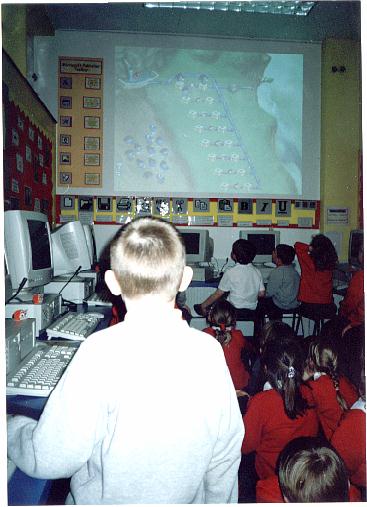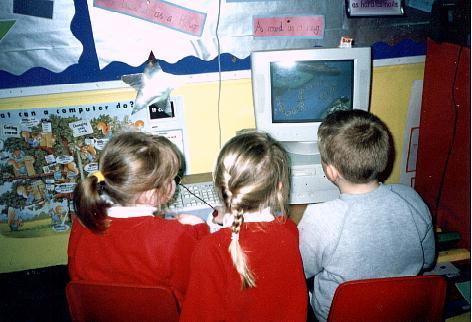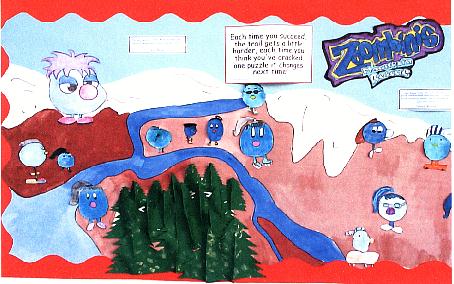
 |
Teaching Thinking and ICT |
|
Using 'Zoombinis: Mountain Rescue' to develop children's thinking skillsCarrie Hoskinson
and Michelle Frank
|
| In both year groups, this program was introduced to children as a whole class using an overhead projector in an ICT suite. This created a good forum for initial discussion and justification. Children were immediately intrigued by the attractive nature of the program and the adventure story which complimented the graphics on screen. These were key motivating factors in stimulating children's interest and curiosity. |  |
Both classes were shown the main map showing the whole journey that they needed to take and the puzzles they would encounter on their challenge to reach Booliewood. Children were introduced to the games by selecting a puzzle from the practice mode option. In Year 2 we focused upon the following puzzles: Turtle Hurdle, Pipes of Paloo, Chez Norf and Snowboard Gulch as these games seemed to be more appropriate for this specific year group. By comparison, in Year 4 all puzzles were attempted with the children. Selecting games in this way in practice mode allowed a real focus on one particular puzzle as well as an opportunity for the children to evaluate and refine their thinking about the game itself and the strategies to be used. This option also allowed children who had failed on a puzzle to keep enough Zoombinis and progress to the next challenge and succeed later on. Children really benefited from the whole class introduction to these games as this gave children the opportunity to think beyond 'where do I click and go now ?' For both year groups, we found that plenty of practice was needed before the children could tackle the problems on a higher level that needed them to use more advanced thinking skills. The Teacher's Pack (there is a copy on the CD) really enabled the teachers to achieve quick familiarity with the game, to understand how the puzzles work and how to manage the program. This allowed us to concentrate more readily upon the educational features of the program rather than being preoccupied with technicalities, which can be extremely time consuming.
In Year 2, children worked as a whole class, progressing to working in small groups of 2 or 3 on the games mentioned previously. In Year 4, this program was used as a stimulus to develop thinking skills with;
In these situations, children were given the opportunity to share, question and discuss a problem through a stimulating medium. Children not only learnt to think for themselves but also how to learn from the thinking of others. The discussion with a partner or with a group was invaluable in deepening the children's understanding of the puzzles and refining their thinking. Children were very much encouraged to complete the tasks in their own way. To learn from their mistakes and to develop and readjust their ideas. Children were not afraid to take risks and to challenge thinking. Valuable time was spent reflecting upon the puzzles both at the start, during and at the end of a game.

The program was suitable for all abilities, given its depth in puzzles and differentiation in terms of level of difficulty. All children in the Year 4 class worked with a partner on the Green level - 'not so easy.' This proved a suitable level of difficulty to develop the thinking skills of the children. More able children did try various games on the Yellow level 'Oh so hard' but with the exception of Chez Norf and Aqua Cube these proved to be a little too demanding. Competition between individuals and groups became evident as children's familiarity with the game developed. Children would frequently compare their best stage reached on the journey and would use this as a target to try and beat on their next game. This proved motivating as children could foresee a real opportunity for success.
Children were asked to reflect upon their favourite games as well as which puzzles they perceived to be the easiest and the most difficult. These questions were used as the basis for discussion and helped children to come to a shared understanding of the game and of themselves as players. Some of their responses follow:
'My favourite game is Beetle Bug Alley because it takes a lot of hard work to figure it out but it's a fun game too.'
'I like Zoombinis because you learn a lot about problem solving while you are excited and having fun too. I don't have a favourite game. They are all brilliant.'
'I like Aqua Cube best because it is quite complicated and you have to really think carefully about which direction the ball will move.'
This program proved successful in encouraging children to approach the puzzles with an open mind and involved them in critical thinking, risk taking and problem solving. Children were able to find a variety of solutions to a problem through:
The main skills that children developed in this collaborative working was effective communication. Children had to really develop their ability to explain and justify to someone else their thinking, even if someone else disagreed with their logic. This was the main aspect that children found most difficult. How would they come to a compromise in solving the puzzle when there were two or more opposing ideas ? Children had to understand the importance of using the most appropriate vocabulary as well as being really clear in their explanations. They had to learn to listen to and respect others ideas. This program definitely offered a co-operative dimension, and a real medium in which to develop moral understanding and practise social skills.
The Year 4 class devised and agreed the following strategies for solving the puzzles on this program:
While working on this program, a number of important elements of thinking were observed by the children. These included:
We think that main benefit of this adventure simulation is that
it involves practising a number of skills, developing concepts and
strategies for problem solving in an enjoyable game environment.
This program definitely generated enthusiasm, excitement and put
real fun into the children's learning. Its compelling and interactive
nature had a significant impact in motivating children's interest
and activity. A key aim of the work going on at Langley is to develop
children's thinking skills throughout the school, and this program
added variety to what was being taught and learned in other thinking
skills approaches. We very much feel that this is not a game to
be played passively: it requires co-operation with others to be
played most effectively. If children are puzzling out together how
to tackle a problem this has the advantage of co-operative learning,
learning from and discussing with each other, sharing a challenge
and more often succeeding together than if they had worked on it
alone. It is difficult to say that playing this game will automatically
improve thinking and reasoning skills, but from our own investigation
in using this program there has been a definite improvement in children's
verbal reasoning abilities and their participation in a variety
of group problem - solving activities. A whole-school approach to
promoting and developing thinking skills is needed if there are
to be real and lasting benefits to children's thinking and learning.

|
For more information see the TAG Learning site; www.taglearning.co.uk |
|